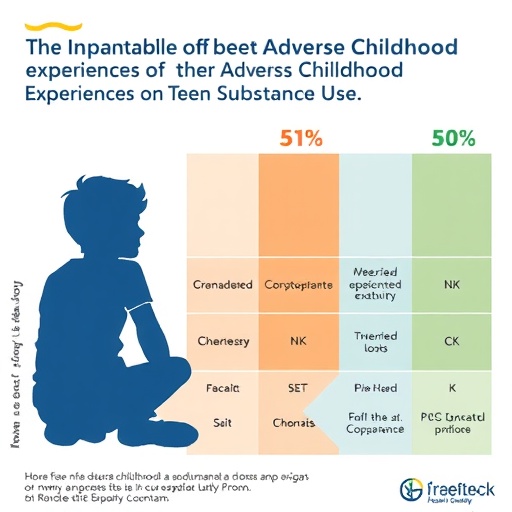Adverse Childhood Experiences Drive Substance Use Among Adolescents: An In-Depth Look at Recent Findings
Recent research has shed light on a troubling phenomenon: the correlation between Adverse Childhood Experiences (ACEs) and substance use among adolescent psychiatric inpatients. The study, conducted by a team of experts including Walker, Nester, and Prieto, offers significant insights into how early life experiences shape the likelihood of substance use disorders later in life. This investigation provides a comprehensive understanding of the risk factors at play, addressing a growing public health concern that requires urgent attention.
Adolescent psychiatric inpatients often grapple with complex mental health issues, making it challenging to delineate why certain individuals turn to substances as a coping mechanism. According to the findings, the role of ACEs is proving to be a critical factor in understanding this escalating crisis. These experiences encompass a wide range of traumatic events, such as physical and emotional abuse, neglect, and household dysfunction, all of which can have profound psychological impacts on young individuals.
The implications of this research extend beyond the clinical setting, urging mental health professionals, educators, and policymakers to take a closer look at the environments in which adolescents are raised. As the study illustrates, those with a higher incidence of ACEs exhibited a significantly increased risk of developing patterns of substance use. This correlation underscores the need for targeted interventions aimed at mitigating the impact of early trauma and promoting healthier coping strategies among youth.
One crucial aspect revealed by the study is the complexity of substance use behaviors. It is not merely the presence of ACEs that predicts substance use, but rather the interplay of various factors including the type and severity of experiences faced. Understanding these nuances can guide more effective treatments that address the root causes of addiction risk, rather than solely the symptoms it produces.
Moreover, the study emphasizes the importance of early intervention and prevention strategies. Institutions serving adolescents, including schools and mental health facilities, can benefit from training programs that equip staff to identify signs of ACEs and respond appropriately. Tailoring mental health services to accommodate the specific needs of adolescents with a history of trauma could foster a more supportive environment and help in reducing substance use rates significantly.
As the conversation around adolescent mental health continues to grow, it is imperative that researchers and healthcare providers prioritize the assessment of childhood experiences when evaluating young patients. The study highlights that systematic screening for ACEs could illuminate the underlying issues contributing to mental health and substance use challenges. Implementing such screening as a standard practice could drastically change how treatment approaches are formulated.
Peer influences also warrant attention in this discourse. The adolescent years are characterized by social dynamics that strongly influence behavior, including the decision to use substances. Those who have experienced ACEs may be more susceptible to the influences of peers engaged in substance use, creating a dangerous cycle that further complicates their recovery. Addressing peer dynamics in therapeutic settings may be crucial for this vulnerable population.
To compound these challenges, many adolescents face stigma surrounding mental health issues—a barrier that can discourage them from seeking help. The researchers urge for a cultural shift in how society perceives mental health treatment, advocating for broader acceptance and understanding. A supportive community can play an integral role in breaking down these barriers, ultimately improving health outcomes for adolescents facing adversity.
A significant takeaway from the research findings is that while ACEs present formidable challenges, they do not define an adolescent’s trajectory. Resilience plays a vital role and can emerge despite negative experiences. By focusing on strengths and fostering healthy relationships, mental health practitioners can help adolescents navigate their struggles more effectively, empowering them to build a brighter future.
Interventions that emphasize resilience-building activities, including therapeutic group settings, can create spaces for adolescents to share their experiences and learn from each other. Sharing stories of survival and support fosters a sense of belonging—an essential component in healing from trauma and reducing the likelihood of substance use. Programs designed with these elements can enhance coping skills and provide adolescents with tools to combat their adverse experiences.
In conclusion, the study by Walker, Nester, and Prieto serves as a compelling reminder of the intricate relationship between childhood adversity and substance abuse in adolescents. As public health officials and mental health practitioners reflect on these findings, it becomes evident that addressing ACEs is not simply a matter of treatment but one of societal responsibility. Collaborative efforts are needed to create sustainable changes within communities, schools, and healthcare systems that prioritize resilience and understanding, ultimately breaking the cycles of trauma that perpetuate substance use disorder among our youth.
The pathway forward is clear: increased awareness, education, and actionable interventions are needed to mitigate the lasting impacts of ACEs and to promote healthier coping mechanisms for adolescents facing these adversities. As we foster discussions around these pivotal issues, a more nuanced understanding of adolescent mental health can emerge, paving the way for a more hopeful and resilient future.
Subject of Research: The role of Adverse Childhood Experiences (ACEs) as predictors of substance use among adolescent psychiatric inpatients.
Article Title: Predictors of Substance Use among Adolescent Psychiatric Inpatients: The Role of Adverse Childhood Experiences (ACEs).
Article References:
Walker, T., Nester, C., Prieto, S. et al. Predictors of Substance Use among Adolescent Psychiatric Inpatients: The Role of Adverse Childhood Experiences (ACEs).
Journ Child Adol Trauma (2025). https://doi.org/10.1007/s40653-025-00735-9
Image Credits: AI Generated
DOI:
Keywords: Adverse Childhood Experiences, Substance Use, Adolescents, Psychiatric Inpatients, Mental Health, Resilience




